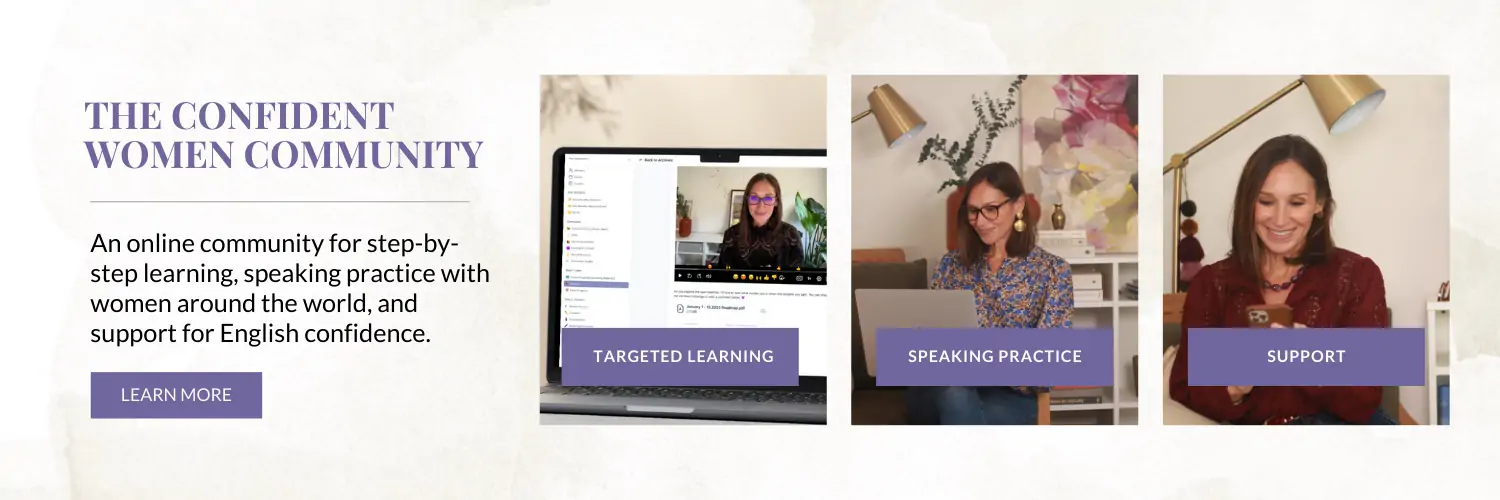#288: Public Speaking Skills | Speak So Your Audience Listens

Have you ever stepped onto a stage to give a presentation in English — or shared an idea at work with 5 of your coworkers — and instead of people looking at you with anticipation, waiting for your next word… you just see confused faces?
And you get that, “Oh no, they didn’t understand or care about what I said” feeling.
Trust me, you are not alone. It’s happened to me too. I’ve spent years – in English and my second language – learning to level up my public speaking skills.
And that’s the good news. Public speaking is a skill. That means it’s something you can improve when you have the right strategies and practice.
If you want to confidently give a presentation in English, knowing that your audience is interested in what you have to say – whether you’re talking to 5 people or 500 – it comes down to one essential public speaking skill: speak so your audience listens.
How can you do that? That’s what I’ll help you do with 3 simple tips in this Confident English lesson.
Psst… 📣 Want to get personalized, in-depth speaking practice with me to boost your English speaking skills? Join me for Fluency School. My VIP Fluency School Program is the most personalized, most transformative course I teach.
English Public Speaking Skills | Speak So Your Audience Listens
Let me start by removing some worry and stress about public speaking in English.
You do not need a highly advanced vocabulary or years of public speaking experience to give a meaningful presentation in English.
The 3 insider tips to speak so people listen just might surprise you, especially number 2. With each tip, I’ll demonstrate how you can apply the recommendation.
And, if you want more on this topic, I have several lessons I recommend including
Tip #1: Know your audience
Before you do anything. Before you give your presentation… before you even plan what you want to say, you have to know your audience.
This doesn’t mean knowing each person individually but rather – who is coming to listen to you speak?
Are you sharing ideas with your coworkers who already have ALL the same background information as you?
Are you speaking to an audience who shares your excitement about a topic? Like watercolor painting techniques?
Or are you speaking to people who have never heard of an issue? Like how to use AI in the workplace.
To know your audience means to know what people already know or don’t know, what they think or believe or feel about the topic.
When you have this information, it will help you better decide WHAT to share in your presentation so your audience is interested rather than feeling bored or lost.
When preparing for your presentation, ask yourself the following questions:
- Why does this presentation matter to my audience?
- Why should my audience care about this?
- What does my audience know?
- What does my audience not know?
- What information does my audience need?
- What are my audience’s needs?
Tip #2: Keep your language simple
I know this might surprise you. We’re so tempted to use overly complicated, advanced-level vocabulary. And I’m here to tell you, you don’t need to. Whew, that’s a relief, right?
Tip #2 is to simplify information as much as possible. That means keeping your language simple.
Simple, relevant language makes information easier to digest or understand. If you want your audience to remain engaged, if you want them to listen, don’t overcomplicate your presentation.
To do this, avoid:
- complex statistics or examples;
- Think how best you can deliver the same level of information in a quick and simple way.
- Can you use graphics, share main takeaways, or create a simple chart?
- Elaborate words or phrases
- In order to → to
- Reconceptualize → reimagine
- Due to the fact that → due to/since
- Complex, run-on sentence structures
And use jargon sparingly or none at all.
Lastly, don’t force your audience to read between the lines or spend too much time evaluating your meaning.
When you keep your language simple, you’ll immediately prevent confusion or the need to read between the lines.
Tip #3: Acknowledge and Speak to Your Audience
What this means is to acknowledge that your audience needs space and time to think about what you’ve said. To give them that space and time, speak to your audience accordingly.
How can you successfully do this?
- Don’t rush. Instead, slow down your pacing, this includes your transitions as well as your speech.
- Use the power of the pauses.
- Remember, pausing can help us maintain a solid pace, highlight and emphasize key details, as well as provide time for your audience to process what’s been said.
- Wait patiently
- During Q&A or after a question has been asked, wait patiently. Some people need time to formulate their thoughts, speeding through this or speaking can interrupt that train of thought.
- Instead, wait 10-15 seconds before moving on.
- Lastly, look at your audience.
- Eye contact with your audience members is the most powerful way to gauge interest/attention and create a connection.
- If you’re feeling a little nervous, transition between direct eye contact and looking ahead and slightly above the audience.
Share Your Questions & Tips
Whether you have experience giving presentations to large audiences or you communicate with small groups at work, I’d love to know…
1. What are the biggest challenges you experience? Share them with me. You might have the next topic for one of my Confident English lessons. 😉 Even better, join me for Fluency School — my intensive speaking course designed to unlock your fluency and confidence.
2. What tips/recommendations do you have based on your experience? Your insight might be exactly what another member of my Speak Confident English community needs right now. 🙌
As always, you can share your comments and questions with me below.
~ Annemarie

Get the Confidence to Say What You Want in English
Follow my 3-step solution to speak English with clarity, fluency, and freedom so you can say what you want with confidence.
You'll also get my Confident English lessons delivered by email every Wednesday and occasional information about available courses. You can unsubscribe any time.
More Like This
Learn English Phrasal Verbs Faster — 5 Minute Routine
Tired of forgetting English phrasal verbs the moment you need them? In this Confident English lesson, you’ll learn a 5-minute daily routine to make phrasal verbs stick—so you can remember them, use them naturally in real conversations, and finally stop second-guessing. Whether you need phrasal verbs for work, everyday conversations, or English speaking practice, this lesson gives you practical steps that fit your real life.
Sound Fluent & Professional: English Phrases for Meetings & Updates
Want to speak English more naturally at work? In this lesson, you’ll learn powerful English phrases for meetings and updates, including business phrasal verbs professionals use every day. Get the vocabulary and expressions you need to give confident project updates, explain delays clearly, and wrap up your message like a pro.
How to Give a Project Update in English at Work
Give a clear project update in English with a concise 3‑step framework. Get the phrases and structure to deliver professional project status reports confidently at work.
Professional Ways to Ask for Help in English (4-Step Formula)
Learn how to ask for help in English at work—without sounding unsure or unprepared. This 4-step formula gives you clear, professional phrases for meetings, emails, and team collaboration.
30+ English Phrases to Compliment Food Naturally and Politely
Learn 30+ natural English phrases for food and how to compliment food in English politely and sincerely. Perfect for dinner parties, eating out, and everyday English conversations.
Describe Food in English: The Ultimate List of Taste & Texture Vocabulary
Learn how to describe food in English with confident, natural vocabulary. Get taste and texture adjectives English speakers use in real conversations, from restaurants to everyday life.
© Copyright 2014-2025 Speak Confident English | Privacy Policy | Terms & Disclaimer | Online Class Policies






My challenge is that I get nervous, panic then black-out.
Thank you for all your help but I am in a special situation; As I am a retired woman I don’t need English to get a job or to get a promotion in a job; I study English alone, at home, as much as possible, through the internet, to reach two purposes: 1) to be able to communicate when travelling abroad by myself 2) because learning a new language is good for our brain health;
Thank you for all your weekly lessons
Hi Tania, thank you for sharing here. Even though this lesson is focused on public speaking, these skills are useful for communicating with anyone. We can use these same strategies when talking with strangers while traveling. 😊
I’m impressed that you’re learning a language to also keep up your brain health! Please don’t hesitate to let me know if there is a specific topic you’d love for me to share a lesson on in the future.